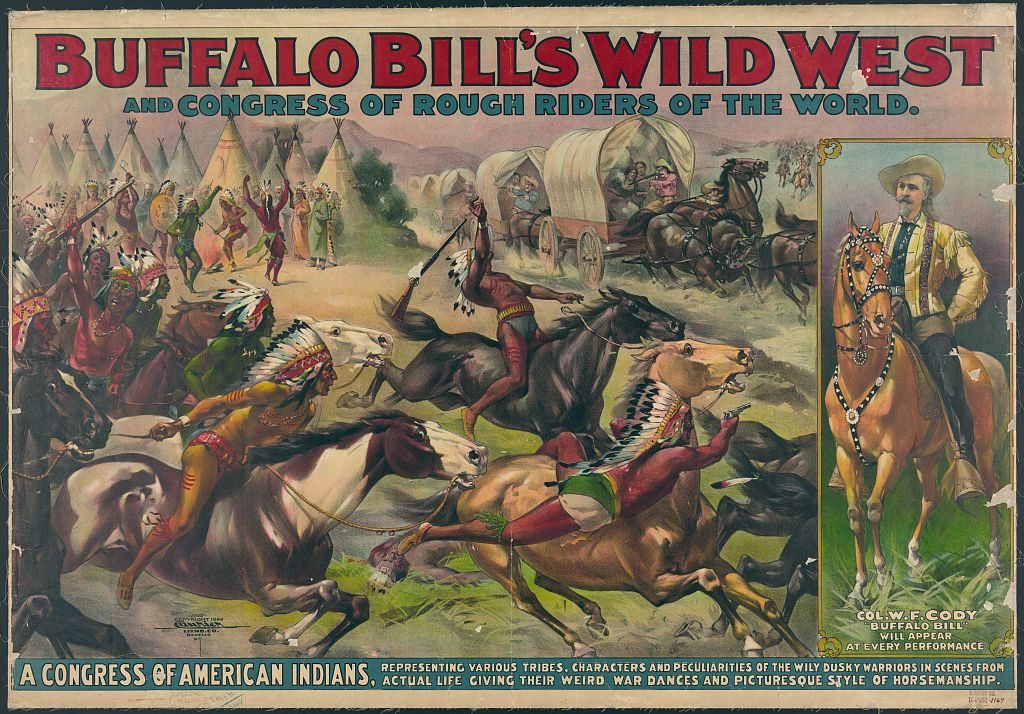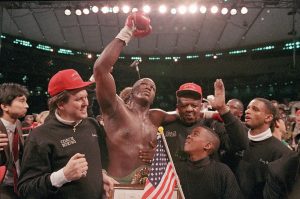In 1883, William “Buffalo Bill” Cody, famous frontiersman, army scout, and buffalo hunter, opened the doors of his Wild West Show for the first time.1 This show was a fantastical, exaggerated portrayal of life on the frontier, complete with reenactments of famous frontier battles with natives, displays by gifted marksmen (and one woman) and horsemen, and shows of the culture of the various Native Americans in Bill’s employ. This show would capture the hearts and minds of many people in the United States, and later on even in Europe, as Buffalo Bill’s show traveled to many European countries between 1886 and 1906.2

One of the reasons for the success of Buffalo Bill’s show was its “authenticity.” Bill himself was already somewhat of a celebrity in the west, after having earned his moniker “Buffalo Bill” for killing some 4,280 buffalo for the Kansas Pacific Railroad Company in the 1860s.3 Bill also had the good business sense to employ many of the Lakota Sioux and other Native Americans, including the man famous for the role he actually played at the Battle of the Little Big Horn, Chief Sitting Bull. It was in its depiction of Native Americans that many of his fans were drawn, enamored by the elaborate songs and dances of these peoples, with Buffalo Bill going so far as to say, “My Indians are the principal feature of this show.”4 The depiction of the Native Americans in his show was largely of their warrior culture, war regalia, and dances made for going into battle; however, this was taking place during the closing of the American frontier, when the death of the buffalo herds and the end of the Sioux Wars had largely ended this way of life in the west.
After roughly four months working with Cody, Sitting Bull grew tired of the show and left to return to the Standing Rock Reservation, where he would eventually be killed. Later in 1890, the Massacre at Wounded Knee would take place and many Sioux would be killed by the U.S. 7th Cavalry, the same regiment that fought with Custer years prior, at the Battle of the Little Big Horn.5 With this, the way of life that was shown in Buffalo Bill’s show was all but destroyed.

Even with this, Buffalo Bill’s Wild West Show continued to be popular up until it went bankrupt and closed in 1916.6 By 1916, the “Wild West” had not truly existed for quite some time; the country had been rapidly industrializing, and the age of both Cowboys and Indians would soon give way to the machine guns and artillery of the First World War. However, it was not the death of the west that ended Bill’s show, but rather the end of interest in the west. Although people praised Bill’s show for its authenticity, it was not authentic to the contemporary west. The show did not feature miles-long slow rides in freezing temperatures on cattle drives, and it did not show subsistence farming. What Buffalo Bill’s Wild West Show gave its audience was the same thing that they grew accustomed to from dime novels and stories of the west: rough and tumble cowboys, crack shots, skilled horsemen, and the Natives that made the west so dangerous. With the closing of the frontier and the nation looking outside of its borders to expand, the west was no longer as exotic as it once was in the public’s eye, and was anything but wild.
- Stephen G. Hyslop, “How the West was Spun,” American History 43, no. 4 (October 2008): 26. ↵
- Irene Lottini, “When Buffalo Bill crossed the ocean: Native American scenes in early twentieth century European culture,” European Journal Of American Culture 31, no. 3 (October 18, 2012): 187. ↵
- Stephen G. Hyslop, “How the West was Spun,” American History 43, no. 4 (October 2008): 27. ↵
- Stephen G. Hyslop, “How the West was Spun,” American History 43, no. 4 (October 2008): 33. ↵
- Stephen G. Hyslop, “How the West was Spun,” American History 43, no. 4 (October 2008): 33. ↵
- Douglas Seefeldt, “Buffalo Bill’s Wild West,” in America in the World, 1776 to the Present: A Supplement to the Dictionary of American History, edited by Edward J. Blum, Vol. 1. (Farmington Hills, MI: Charles Scribner’s Sons, 2016), 163. ↵



63 comments
Griffin Palmer
I found The Buffalo Bill Wild West Show to be a great example of trying to persuade Americans to move further west for opportunities. They would present icons from the west in the show with groups like cowboys and Indians. This show however would create an image of the Indians for the Americans causing greater conflict between the two groups.
Guiliana Devora
I think it is interesting to see how a person could turn the life of the Wild West into a show. I liked how he was able to influence people to even move their lives just because of a show. Although it was not what the true west was about he gave it a sort of appealing aspect to it, it still did not portray the authenticity of it. I understand as to why it ended because the appeal was no longer there and the country was changing and evolving.
Iris Reyna
This was an interesting article and was very well put together to show what Buffalo Bill’s Wild West Show was really about and what it portrayed. I have heard the name Buffalo Bill before but never really knew who he was and what his show was actually about. The show was about both the cowboys and the Indians and told both sides of their cultures. It was nice to know that the show had Native Americans participate in their intended roles. The part of the article I thought was ironic was that Buffalo Bill ran the show that told the story of the Native Americans but was known by name for killing 4,280 buffalo which was their main source of food.
Danielle Rangel
While reading this article I found it interesting how Buffalo Bill’s Wild West Show influenced the majorities’ view on the Frontier. I can definitely see how Buffalo Bill’s Wild West Show affected things like movies due to the stereotype of cowboys and Native Americans depicted. I also think it’s interesting how after the show ended the view on Native Americans became more and more negative. This article is a great way to show the effects of how Buffalo Bill’s Wild West Show influenced the narrative of the Frontier.
Bryon Haynes
If there’s any word I can use to describe this article, it would have to be tragic. From the wrongful depiction of the Indigenous peoples of America to Sitting Bull getting murdered after leaving the show, nothing productive or positive seemed to have come from this experience whatsoever. The prose and information the author provided was stellar and translated the point well, however the situation could have definitely been better, especially knowing Buffalo Bill killed so many of their primary resources.
Isabel Soto
This is a very interesting article about the show. the tone of this article really set the story. I really believe if someone ever needs to learn about westward expansion I feel that someone can learn what it is with this article. It gets straight to the point and keeps it structured. I learn a lot about the westward expansion by reading this article.
Rigel
Excellent article! The images bring more context to the article in some ways, displaying the layout of the show, and the people taking part in it. Before this article, I knew little about the Buffalo Bills’s Wild West Show and think it is ironic that Buffalo Bill was the main cause that buffaloes slowly died out. Also, the fact that years later after Sitting Bull returned to Standing Rock Reservation and a year later the Wounded Knee Massacre happens is tragic.
Walter Goodwin
Although his show was about their culture Buffalo Bill didn’t seem to really help Native Americans position in the west or how they were viewed. He may have employed Native Americans like Sitting Bull but only painted a picture of them as warriors, not as people. In doing so perpetuating (perhaps inadvertently) an idea that cowboys were noble and Indians were the savages.
Hunter Stiles
Hello Nelson! I wanted to congratulate you on the publishing of your article. I think that you represented the history and context of Buffalo Bill extremely well. I really liked that yo provided statistical information and numbers when it came to talking about the death tolls concerning the buffalo. I also like how you incorporated how the end of Buffalo Bill ended with the disinterest in the west as well. Overall, good article. Well written.
Lyle Ballesteros
Great article! Very interesting story about Buffalo Bill and how with the end of the West as some people thought it was his show would end. Also that the Massacre at Wounded Knee had an impact on his show because the west as he portrayed for many years was now completely different. That speaks to how much the removal and massacre of the native population in the west changed it’s perception, which Bill or Cody was responsible for with him killing a lot of Buffalo and fast-tracking the end of live for natives like the Sioux in the West as they knew it.